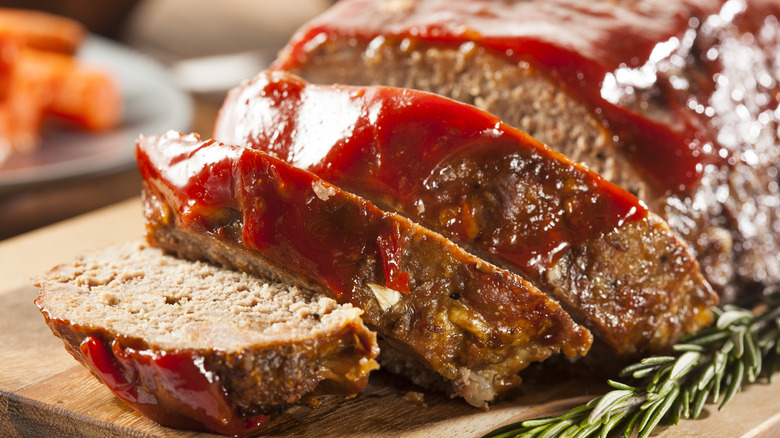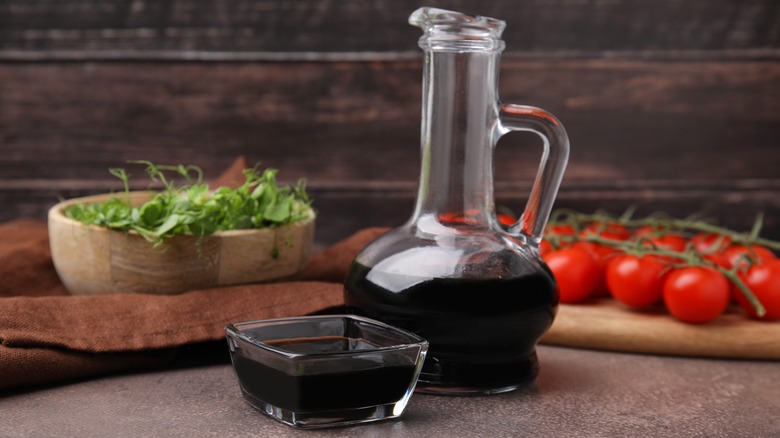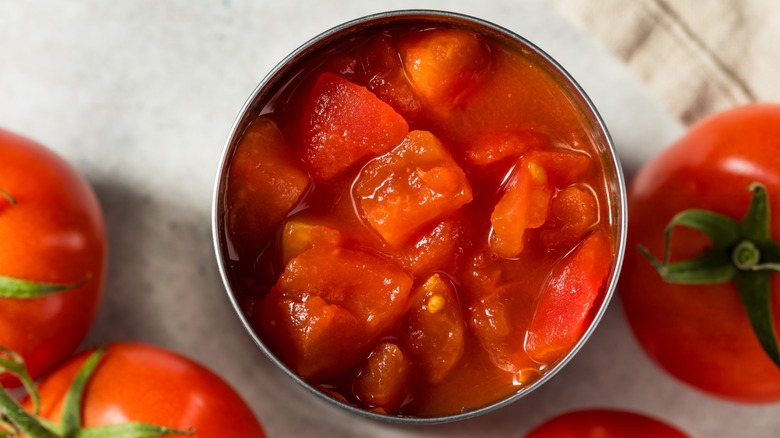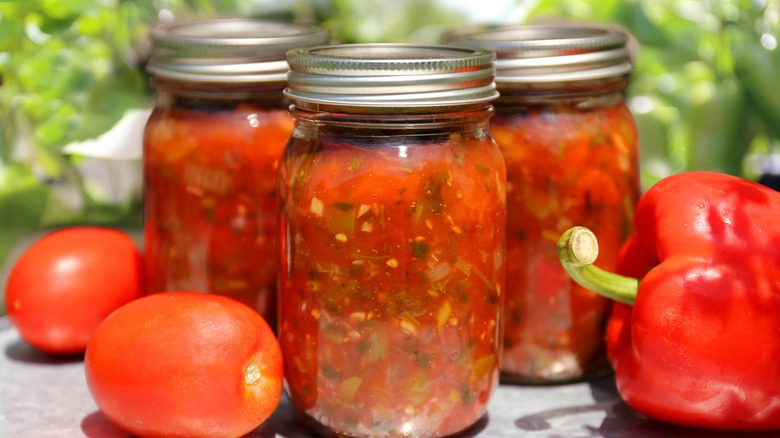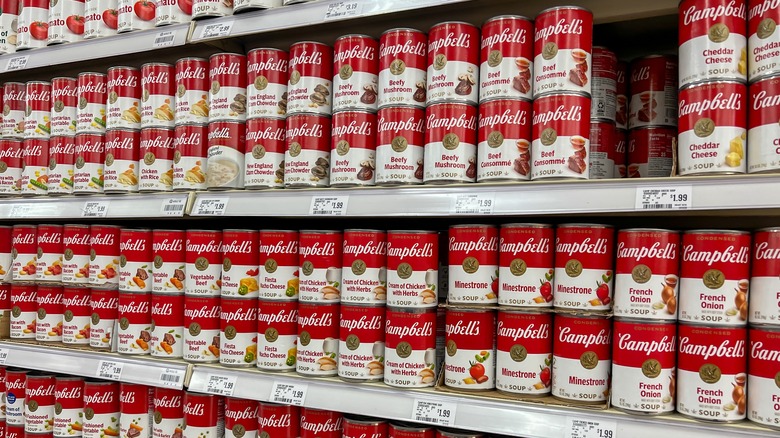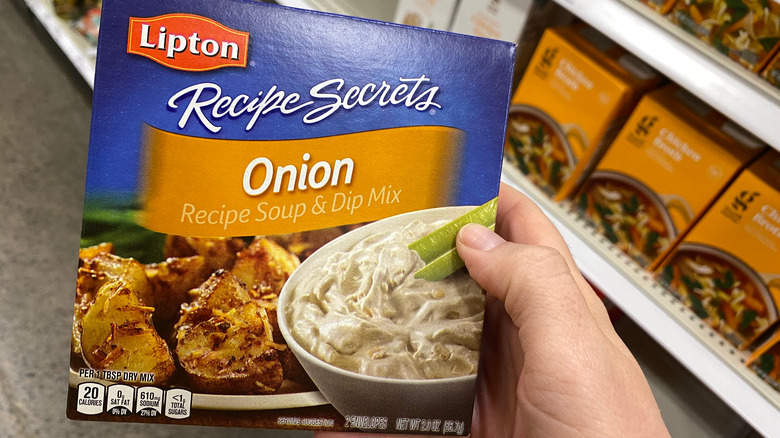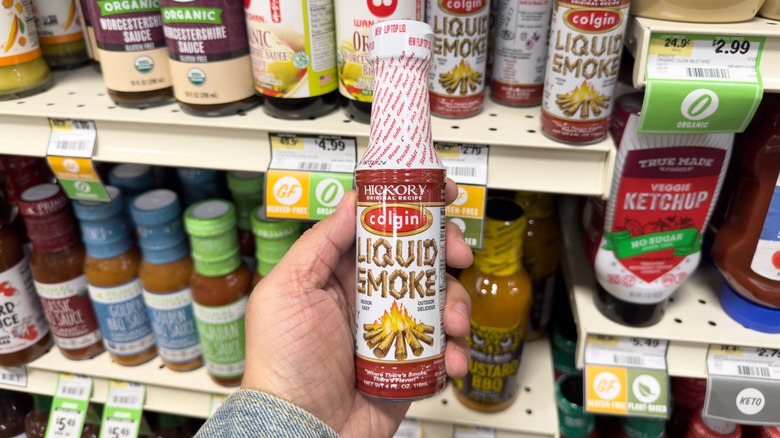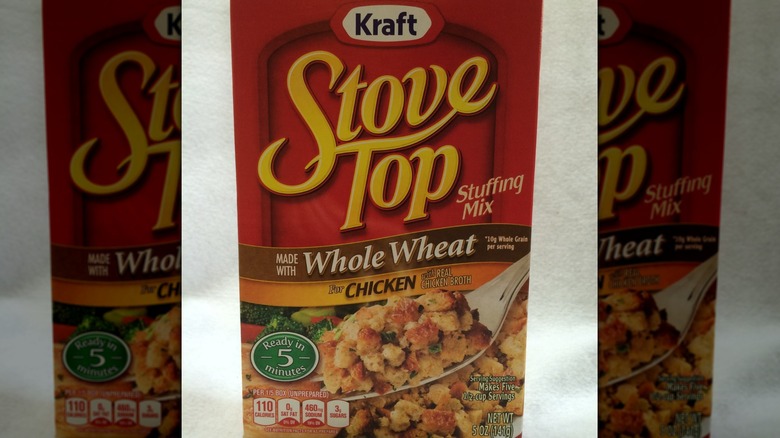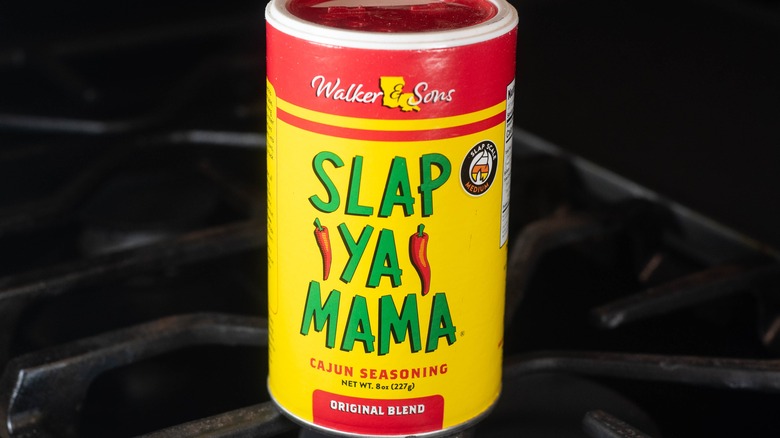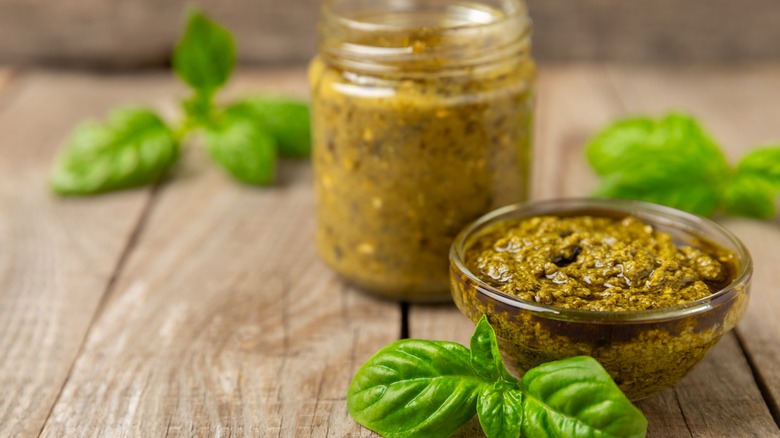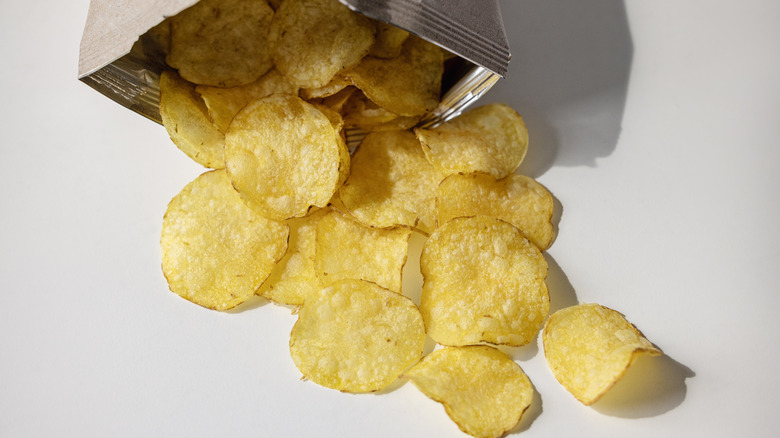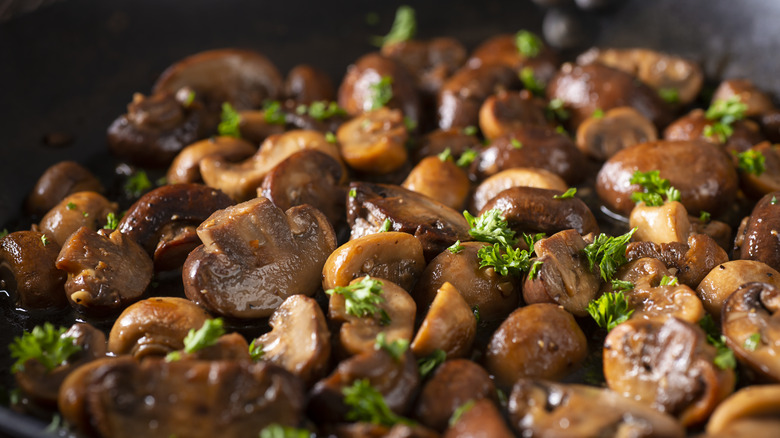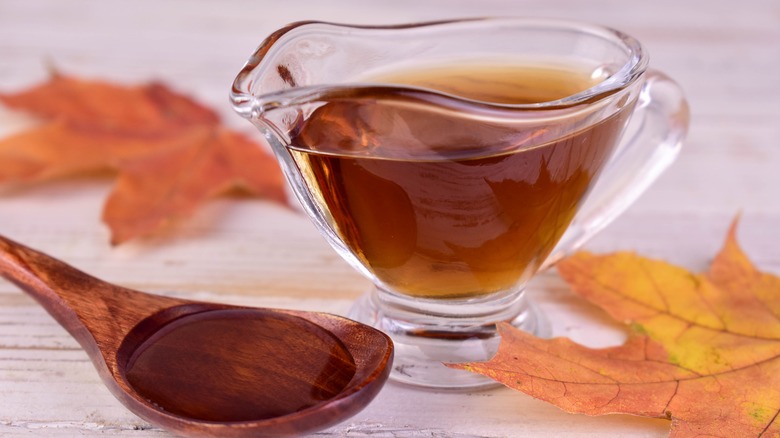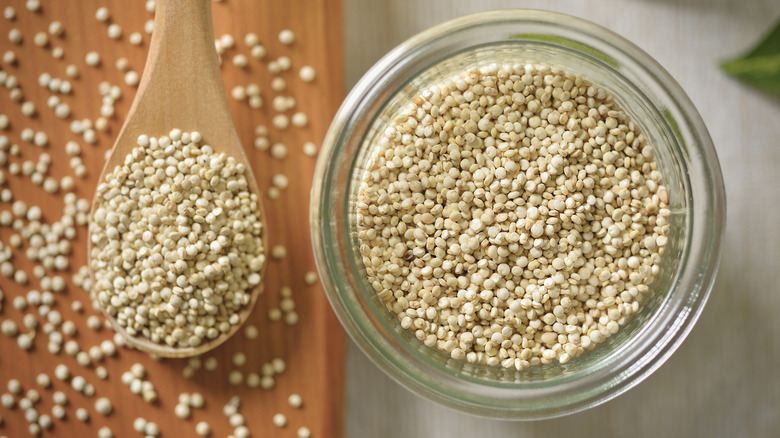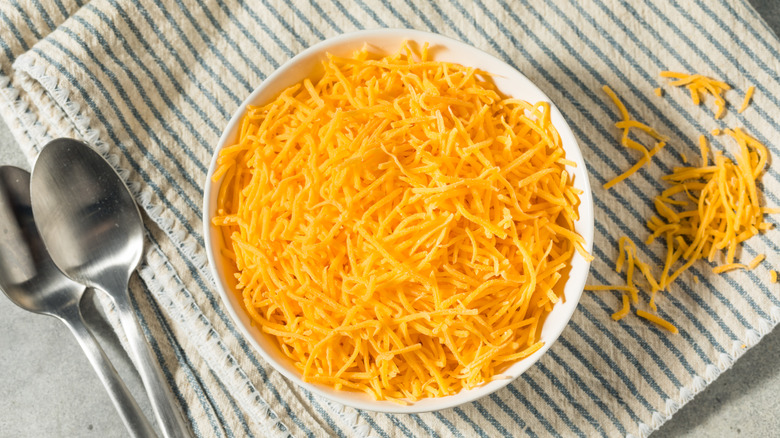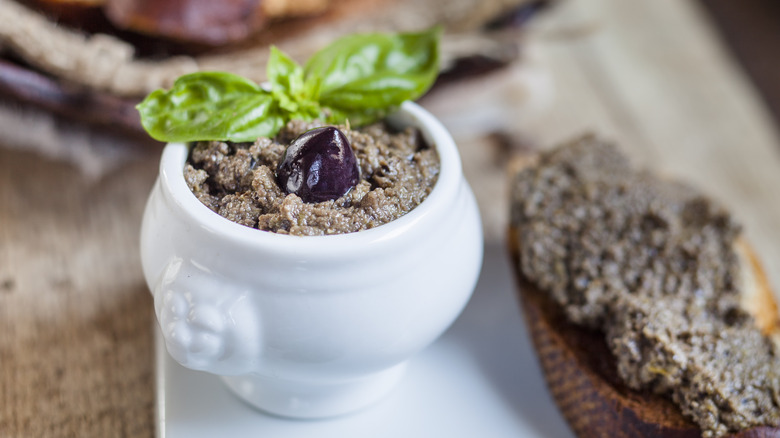Underrated Ingredients That Will Change How You Make Meatloaf
Meatloaf is a pretty standard staple of American cuisine. First appearing in American cookbooks in the late 1800s as a way to cheaply feed a family, early meatloaf recipes look very similar to the meatloaf recipes of today. Take your ground meat of choice (usually beef) and mix it with some sort of binder, like breadcrumbs and an egg or two, add some seasonings, and bake it, and you've got a meatloaf. Serve it with a veg or two and you have a filling, hearty meal that's the very definition of comfort food.
However, while there's nothing wrong with a classic and we all love 'em from time to time, sometimes the basics can get boring. If you find that your typical meatloaf recipe is inspiring more yawns than yums lately, it's time to shake things up. Try one of these underrated ingredients that will change how you make meatloaf, providing new flavors and new textures, and possibly coming in handy when you're in a pinch and need to use up those random odds and ends in the pantry.
Balsamic vinegar
Many meatloaf recipes call for you to add some sort of tomato-based topping to the loaf (unless you're getting fancy and adding a lattice of bacon). This topping adds both flavor and moisture to your loaf, and also makes it look a little more tantalizing (a bare rectangle of baked meat isn't the most appetizing thing in the world). The go-to options are firstly just plain ketchup, and then barbecue sauce, depending on where you grew up.
However, while it's easy to just grab the bottle of ketchup from the fridge, squirt a layer over your meatloaf, and call it a day, consider adding a little more flavor to that ketchup with some balsamic vinegar. Balsamic vinegar provides a nice, rich flavor profile, with some sweet tang. Just don't add too much. Start with a little bit and add the vinegar to taste. If you find that you've added too much and now your sauce has a distinctly vinegar-y flavor, consider adding some brown sugar, too.
Diced tomatoes
If you don't already add any vegetables to your meatloaf mix, it's time you began. Vegetables add both extra flavor and texture to what might otherwise be a relatively bland and basic loaf. However, if you don't have any fresh veggies on hand, like bell peppers or zucchini, nor the time to be chopping up extra ingredients before tossing your loaf in the oven, consider reaching into the pantry for a staple that most home cooks always have on hand: a can of diced tomatoes.
Be sure to drain your diced tomatoes before adding them to your meatloaf mixture, so you don't throw off the texture by adding excess liquid. Don't just tip the can into the sink either, and call it drained. Pour the tomatoes into a colander, rinse and thoroughly drain them, and consider giving them a couple firm pats with a paper towel, as well. The addition of diced tomatoes is key if you're making a Cracker Barrel copycat meatloaf, which utilizes not just diced tomatoes, but also diced green bell pepper and diced onion, too.
Salsa
Like the idea of adding tomatoes and other veggies to your meatloaf mixture, but don't have any canned tomatoes on hand, don't want to do any chopping, and, besides, you'd really like to add more veggies beyond just tomatoes anyway? Reach for a jar of salsa. With tomatoes, peppers, and onions, it'll pack a lot of veggie flavor with little work on your part.
If you add salsa to your meatloaf, opt for a chunkier salsa, so that the texture really carries through to your final, baked meatloaf. Though, if you're just hoping for extra flavor, not texture, a salsa with a smoother consistency is fine. For a more traditional meatloaf flavor, choose a salsa that's mild and that doesn't have a heavy cilantro taste; for a meatloaf with more of a Southwest flair, go with the heat level and flavor profile of your choosing. As for any worries about the salsa adding extra moisture to the mix, you can use the salsa in place of any ketchup or similar tomato products (like tomato paste) in the loaf mixture, and/or use it as part of your sauce for the top.
Canned cream of soup
Like diced tomatoes, most home cooks have a few cans of "cream of" soups sitting around in the pantry. These canned soups can act as an excellent binding ingredient for your meatloaf, adding flavor and moisture, without adding too much moisture. Just don't add the milk to the soup that's called for on the can. Instead, use the soup like you would in any casserole recipe. Just pop the top off and add the soup to your meatloaf mix.
While technically any "cream of" soup will work in your meatloaf, cream of mushroom soup is a favorite for how well mushrooms pair with the other ingredients typically found in meatloaf, like beef. Cream of celery is another option, though, as is cream of broccoli, cream of bacon, cream of onion, cream of potato, or cream of asparagus. You can also create a gravy with the soup, for serving with the meatloaf after it's finished, by heating the soup with a little milk and spices like pepper, sage, and thyme.
Onion soup mix
While you're in the soup aisle, snag a few packs of onion soup mix. Onion soup mix is your secret weapon for a more flavorful meatloaf, without the need for chopping any vegetables or, in this case, even opening a can. Onion soup mix is an incredibly versatile ingredient that you should always have on hand anyway, and when you add it to your meatloaf, you'll see why.
Just adding it to the meat mixture before baking adds a large helping of savory flavor, and negates the need for chopping and adding a fresh onion, as well as measuring out ingredients like salt. The onion mix already has all the salt you need, so don't think you need more and add it in, or you could end up with a loaf that's too salty to consume. If that does end up happening, don't toss the loaf, though. You can save it by repurposing it. Try crumbling it and adding it to (unsalted) tomato sauce for a hearty pasta sauce, for example.
Liquid smoke
For a meatloaf that carries the flavors of hours-long smoked beef, consider adding a bit of liquid smoke to your favorite meatloaf mixture before baking. If you've never cooked with liquid smoke before, it's basically an essence made from actual smoke and it's all-natural, not an artificial flavor. Be careful, though. Liquid smoke is quite potent, so you really only need a few drops, often less than a teaspoon. Add this small amount to your meatloaf at first, and then if you feel like you need more smokiness, you can always increase the amount of liquid smoke you use later. You can add the liquid smoke to the actual meat mixture, or you can add it to the sauce or glaze you put on top.
Of course, if you want a more intensive cooking project, you can literally smoke your meatloaf. You'll need a smoker, of course, and it'll take a few hours, but, with the right recipe, you can have a smoked meatloaf that's smoky, succulent, and moist.
Stuffing mix
Meatloaf requires some sort of binding agent to keep it altogether, in loaf form. While the binding ingredients will differ from recipe to recipe, most often, they're an egg or two plus some sort of gluten-based ingredient. Some recipes will call for milk-soaked white bread. Others call for soaked breadcrumbs. However, take your meatloaf to the next level by ditching these bland options for something with a little more flavor: boxed stuffing mix.
Another one of those oh-so-versatile and super-convenient ingredients that you should always have in the pantry, stuffing mix can easily hold your meatloaf together, while also providing structure and seasonings. Skip the chicken-flavored stuffing (unless you're making a ground chicken meatloaf) and go for a sage, mushroom and onion, beef, cornbread or tomato and onion stuffing mix. Remember to still soak the stuffing mix, just like you would breadcrumbs or another binding ingredient, before adding the stuffing mix to your meat.
Crackers
Another potential binding ingredient for your meatloaf, crackers are a great choice after crumbling and soaking them in milk, water, or broth. Just note that since you'll be crumbling the crackers, they won't give you the same texture differences that you might get from stuffing mix. Instead, you'll have a meatloaf with a smoother, more consistent texture.
Another good thing about choosing crackers as your binding ingredient is that there are just so many types of crackers to choose from. Saltines are a popular choice, but you can also reach for your favorite buttery Ritz or Club crackers, which is what you'll find in copycat Cracker Barrel meatloaf recipes. The only downside to using crackers as your binding agent? They won't provide very much in the way of extra flavor, like stuffing mix might. While that's a good thing for some recipes that bring in big, bold flavors in other ways (like through the use of liquid smoke), just keep in mind that you'll need to still add your other seasonings.
Cajun seasoning
Cajun seasoning can give your meatloaf a bold, smoky, spicy flavor profile, and all it takes is a few teaspoons added into your meat mixture before baking. You can buy Cajun seasoning at the store, pre-mixed and ready to use, but you can also make some by using ingredients you may already have on hand, if you have a pretty robust spice rack. Cajun seasoning typically contains a mix of garlic powder, onion powder, cayenne pepper, regular pepper, and paprika, but you can also add in red pepper flakes, oregano, salt, and/or cumin.
If you do decide to go this route, consider making your meatloaf even more Cajun-inspired by adding in the holy trinity. This mixture of vegetables — carrots, celery, and double onions — is the mirepoix of Cajun cooking and appears in many a Cajun recipe. Along with working well with Cajun seasoning, the mixture can also add texture and variety to your meatloaf.
Pesto
Who said that meatloaf had to feature only all-American flavors? Give your meatloaf an Italian touch with a classic meatloaf recipe with a twist. Pesto can become your secret meatloaf ingredient, taking your loaf from boring and dry to moist and flavorful. Pesto's garlic and basil adds extra flavor, while the pine nuts provide texture, and the olive oil adds moisture.
Add about ½ cup of pesto to a meatloaf that uses 1½ pound of meat. If your recipe calls for adding tomato paste or ketchup to the meat mixture, you can leave it out, as the pesto will be doing the work here. After you've mixed all your loaf ingredients and formed your loaf, use the pesto as part of your glaze on top of the meatloaf, as well. You can use just pesto or mix pesto with the more traditional ketchup. For even more Italian flair, consider adding in some Parmesan cheese, too.
Potato chips
As mentioned, meatloaf requires a binding ingredient, and often that binding ingredient is some sort of gluten-containing item. While bread or breadcrumbs are pretty typical, even the alternatives we've suggested here, like crackers and stuffing mix, are gluten-based. This means, if you're trying to make a gluten-free meatloaf, you have to get a little creative. Sure, you could use gluten-free breadcrumbs or bread, but as many gluten-free home cooks can attest, most brands' gluten-free bread products leave a lot to be desired. So why not use something tasty that's just gluten-free by nature? Enter, potato chips.
Using crushed potato chips as your meatloaf's binding ingredient in place of soaked bread eliminates the gluten, adds flavor, and adds texture. If you decide to use this ingredient swap, though, just be sure your recipe packs in plenty of moisture elsewhere (to make up for losing the milk in the milk-soaked bread). Rachael Ray's meatloaf recipe with a potato chip twist is a good choice.
Mushrooms
If your go-to meatloaf recipe calls for adding vegetables, it's probably going to call for adding diced onions and green bell peppers. These seem to be the two favorited options. However, why not skip the bell peppers and, instead, go for something a little more surprising, while oh-so-flavorful? Sautéed or roasted mushrooms add moisture, umami flavor, and texture to your meatloaf. Plus, mushrooms work well with the beefy flavor profile of a classic meatloaf, but they also pair nicely with a turkey meatloaf, too. You can even use mushrooms as a binding agent in place of bread, if you're making a paleo meatloaf.
For more umami mushroom goodness, buy some extra mushrooms and make a mushroom gravy to go atop your meatloaf once it's finished. All you have to do is cook some mushrooms, then make a beef broth-based gravy in the same pan, then add the mushrooms back into the gravy mixture.
Maple syrup
Yes, a good meatloaf leans more savory than sweet (and if your meatloaf does come out sweet, it's time to double-check that that's actually salt in your saltshaker). However, really excellent meatloaves have a somewhat complex flavor profile, with a mix of savory, salty, sweet, tangy, and umami-rich notes. As for the sweetness, many recipes often get that from a little brown sugar added into the glaze or sauce on top of the loaf. However, you certainly don't need to limit yourself to brown sugar. Maple syrup is also a great option.
Just add a few tablespoons of maple syrup to a traditional ketchup-based glaze, along with a tangy ingredient to balance things out (like mustard). Make sure to buy real maple syrup for this, though. You want the true maple flavors to shine through, and the fake stuff tastes, well, fake. This mixture pairs particularly nicely with a turkey meatloaf.
Quinoa
Just like potato chips, quinoa makes a great gluten-free swap for the traditional breadcrumbs or bread that you might find in some meatloaf recipes. Unlike potato chips, though, quinoa comes with all its added health benefits, such as lots of nutrients, antioxidants, fiber, and protein.
If you do decide to make a quinoa-based meatloaf, it's worth noting that you do have to cook the quinoa before you can add it to your meat mixture. This does mean that making your meatloaf will overall take longer. However, if you have some leftover quinoa on hand, you might just find that this is the perfect way to use it up (leftover quinoa only lasts about three to five days in the fridge). It's not just the breadcrumbs that quinoa can replace in your meatloaf, though. In some vegan recipes, quinoa actually takes the place of the meat, alongside lentils.
Cheese
Given Americans' propensity for adding cheese to every food possible, you would think that cheese would be a more popular addition to the great American meatloaf, but, alas, that's not the case. You can change that, by adding cheese to your meatloaf on the regular. But with so many cheeses out there, which is the right pick for meatloaf?
Well, you'll want something with the right flavor profile (meatloaf is probably not the place for an ultra-pungent cheese), as well as something that will melt up nicely as your meatloaf bakes. Try a Monterey jack cheese paired with a flavorful blend of beef, pork, veal, and sausage, for a rich, tender rococo meatloaf. For something a bit bolder, make a lamb meatloaf with feta and a blend of rosemary, marjoram, and garlic. Of course, if you want to stick to tradition as much as possible, cheddar works well with any classic meatloaf recipe.
Olive tapenade
Like sautéed mushrooms or pesto, olive tapenade can add a trifecta of goodness to your meatloaf recipe, providing moisture, flavor, and texture all at once. In fact, olive tapenade can do so much heavy lifting for your meatloaf that, in a basic olive tapenade meatloaf recipe, all you really need otherwise is your ground beef, eggs, bread crumbs, and seasonings like salt and pepper. Though it is a good idea to get extra olive tapenade, for serving on the side.
If you're not familiar with olive tapenade, it's basically a French spread or condiment that's made from finely chopped olives, capers, and olive oil. Sometimes it also contains a few other ingredients, like anchovies. Regardless of extra ingredients, though, the result is always the same: a salty, umami dream that's excellent whether it's just spread on bread or mixed into your meatloaf. As is the case with adding onion soup mix to your meatloaf, when adding olive tapenade to your meatloaf, go easy on the salt, as olive tapenade is often already quite salty on its own.
